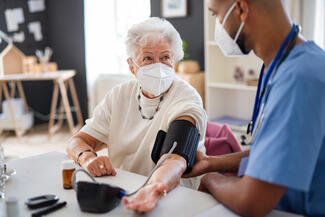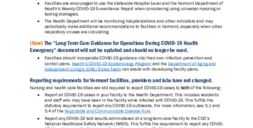This information is for long-term care facilities, other supportive group living setting, and their staff. If you are a member of the public, or a loved one of someone living in a long-term care facility, and are looking for information about specific facilities, please contact the facility directly.

The Health Department works closely with the Department of Disabilities, Aging and Independent Living (DAIL) and long-term care facilities to help them prepare for cases of COVID-19. Other types of group living settings, also called congregate care settings, can follow strategies to detect and prevent the spread of respiratory viruses like COVID-19.
For return-to-work and other guidance for staff with COVID-19 or COVID-19 exposure, please see CDC's Interim Guidance for Managing Healthcare Personnel with SARS-CoV-2 Infection or Exposure to SARS-CoV-2.
Long-Term Care Facilities are encouraged to report new COVID-19 situations (one or more cases of COVID-19 in your facility) using the Vermont Department of Health Online Outbreak Report Form. Do not use this link to update ongoing outbreaks that have already been reported to us. Phone or email can also be used to report cases to the Department. Positive COVID-19 test results should still be reported to the CDC's National Healthcare Safety Network (NHSN).
The federal COVID-19 Public Health Emergency (PHE) declaration ended on May 11, 2023. This memo below summarizes how this change affects Vermont's long-term care facilities:
Long-Term Care Guidance After COVID-19 Public Health Emergency memo

